How Can I Tell if My Air Ducts Are Leaking?
October 18, 2022
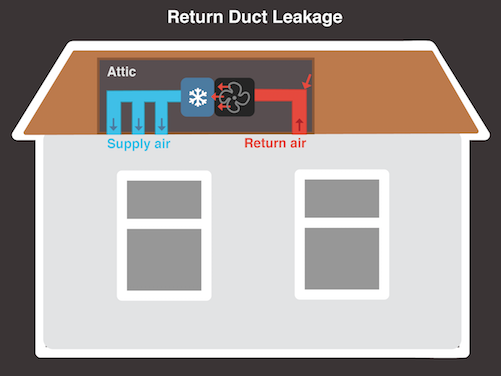
According to Energy Star, most homes lose anywhere from 20 to 30 percent of conditioned air to leaky air ducts.
That’s a lot of wasted air.
So how do you know if this is happening in your home?
Well, signs of leaking ducts include:
- Higher-than-average utility bills
- Uneven cooling/heating throughout the house
- Excessive amounts of dust in your home
- Visual confirmation that air is leaking from your ducts
Now let’s take a closer look at each of these signs and what you should do if you think you have leaky ducts.
Higher-than-average utility bills
If you have leaky ducts, your HVAC system has to work harder and longer to reach and maintain your desired temperature. And that means higher utility bills.
Let us explain how that works in more detail.
Think of your HVAC system as a living, breathing thing. One one side of the system (the return side), your system breathes in air from inside your home. On the other side (the supply side), it exhales conditioned air back into your home.
Duct leakage can happen on both sides of the system:
Leakage on the return side means hot air from your attic is getting sucked into your ductwork. And the more air your ducts suck in from your attic, the less air it needs to suck in from inside your home. Over time, that means your system gets “unbalanced”, meaning it’s blowing more air into your house than it’s taking out. This is called “positive pressure”. But if there’s too much positive pressure, it pushes conditioned air outside the home through tiny gaps in windows, doors, etc.
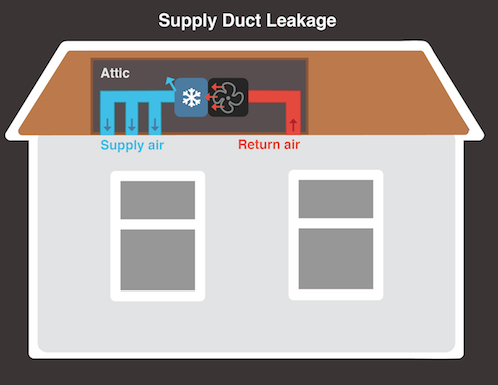
Leakage on the supply side means your ducts are blowing cool air into spaces that don’t need it (attic or basement). So all that conditioned air that you’ve already paid for is wasted and your HVAC system struggles to cool or warm your home.
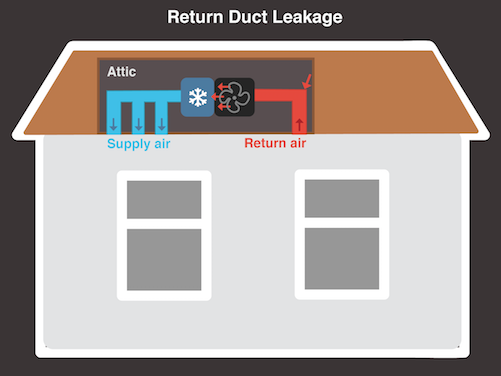
Uneven cooling/heating throughout the house
Leaky ducts can lead to stuffy rooms or specific areas of the house that can’t be cooled or heated.
Why?
Well, your ductwork branches throughout your entire home, delivering conditioned air to different areas of your house. But if one of those branches is leaking, less conditioned air will reach the room that that branch serves.
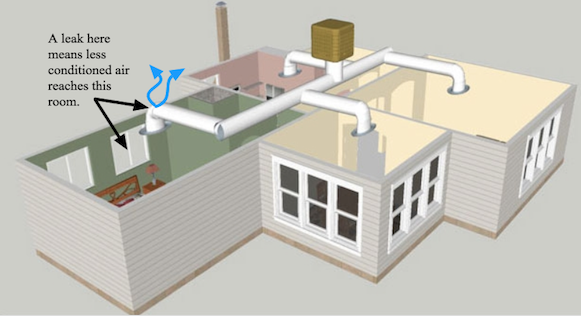
Source: skyaircooler.com
Excessive amount of dust in your home
If there are holes or leaks on the return side of your ductwork, it will pull in the dust and air pollutants from your attic or basement. And once that dust and dirt enters your ductwork, it will inevitably end up into your home.
You’ll notice that no matter how much you clean, you can’t get rid of the unusual amount of dust in your home. That’s because every time you turn your HVAC system on you pull in more dust.
Visual confirmation
If you’re still not sure if you have leaky ducts, there’s nothing like some good ‘ol fashioned investigating.
Once you locate and can visually inspect your ductwork, look for:
- Loose duct connections
- Kinks in flexible ducts
- Holes in ducts
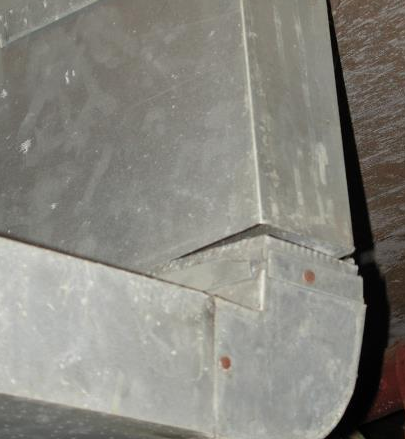
A loose duct connection.
Source: inspectapedia.com
ny and all of these signs indicate that you’re wasting some amount of conditioned air.
Note: It can be hard to visually inspect ductwork, especially if your ducts are located in an attic or crawlspace. Unless you know what you’re doing and looking for, we suggest having a professional inspect your ductwork for leaks.
See the signs? Consider duct sealing.
If you’ve noticed some signs of duct leakage, you can fix the problem by having your ducts sealed.
What is duct sealing?
Duct sealing is exactly what it sounds like: sealing up any small leaks or holes in your duct system. However, duct sealing is slightly different depending on the method used.
There are a variety of different methods for duct sealing, but a few of the most common include:
- Foil tape (external sealing)
- Masking (external sealing)
- Aeroseal (internal sealing)
Let’s look at each of these methods in a little more detail.
Foil-backed tape- Foil-backed tape is exactly what it sounds like. It’s a type of tape that is backed by foil and is resistant to temperature changes, allowing it to do its job through the different seasons and fluctuating temperature of air flowing through your duct system. Foil-backed tape is a great option for small and visible leaks or cracks, like the seams between two pieces of ductwork. However, foil-backed tape isn’t as effective as other methods when it comes to really small holes that aren't immediately visible to the human eye.
Masking- Masking is a type of sticky, rubber cement that can be painted or pasted over cracks and small holes in your ductwork. Masking is a fairly messy type of sealant but is effective for smaller holes and joint racks. For larger holes, a mesh tape can be applied and then masking can be painted over it. Since masking is applied on the outside of your ductwork, it can only be applied over leaks and holes that are accessible and visible from the outside of your ductwork.
Aeroseal- Aeroseal is a aerosol sealant that is pumped into your duct system from the inside and seals leaks as it moves along your ducts. Aeroseal is probably the most effective duct sealing method because it can detect even the smallest holes (naked to the human eye) and fill them from the inside. Aeroseal is the most expensive duct sealing method but has an expected lifespan of 40 years, so it’s worth the investment.
Not sure which method is best for you? Our suggestion would be to have a professional assess your ducts to determine how extensive the leaks are and provide a recommendation on which type of duct sealing method would work best.
Benefits of duct sealing
Benefits of duct sealing include:
- Reduced dust and allergens
- Longer HVAC lifespan
- Decreased energy consumption
Benefit #1: Reduced dust and allergens
A properly sealed duct system will prevent extra dust and debris from circulating throughout your home, resulting in cleaner air.
Your duct system works by distributing filtered and conditioned air from your HVAC system to the different rooms in your home. Your ducts typically run through uninsulated areas of your home, like an attic or crawl spaces, which can be very dusty and dirty.
Inevitably, if there are holes or leaks in your duct system, dust and other debris from the attic or crawl spaces can get sucked into your ducts and distributed throughout your home. This is bad news for anyone with allergies.
To make sure you and your family breathe clean, quality air, it’s important to have an efficient duct system that is sealed tightly. This will reduce the amount of dust and debris that’s circulating throughout your home.
Benefit #2: Longer HVAC lifespan
Duct sealing can increase your HVAC system’s lifespan by helping it run more efficiently.
The average lifespan of an HVAC system is about 10 years, but a unit that runs around the clock won’t last nearly that long.
If your home’s duct system is full of leaks and holes, it will have to work harder to maintain the internal temperature of your home and keep your family comfortable. The harder your HVAC system has to work, the more likely you’ll need repairs due to an overworked system.
Having sealed, efficient ducts is one of the main factors that will affect the lifespan of your HVAC system, apart from proper installation, regular maintenance and consistent air filter changes.
Benefit #3: Decreased energy consumption
If your ducts have leaks, your HVAC system will waste a significant amount of conditioned air (and energy).
According to Energy Star, a leaky duct system may waste up to 20% of the energy that your HVAC system produces. Not only is that bad news for your wallet, but it’s also harmful to the environment because it burns more fossil fuels.
Duct sealing reduces the amount of energy needed to heat or cool your home. That means you’ll pay less to stay comfortable year-round and ultimately decrease the amount of pollution your home creates.
Ready to seal the ducts in your home? Advanced Air is here to help
Duct sealing can go a long way to reduce the dust and allergens in your home, decrease your energy consumption, and extend the lifespan of your HVAC system. What’s not to love, right?
Advanced Air can help you reap those benefits with our thorough Aeroseal process and guaranteed 5-star service.
To seal your ducts, we’ll pump Aeroseal directly into your duct system from the inside, ensuring that even the smallest holes and leaks are completely sealed as it moves through your ducts. We’ll also use a computer to detect and monitor leaks as they’re being sealed and give you a before and after screenshot of your duct leakage so you can see the difference the sealant has made.
If you’re ready to get started, call today or schedule your service online.
- Posted in:
- Air Conditioning,
- Air Quality

